A new study shows a pretty startling correlation between eating red meat and dying!
Apparently eating ~1/4 lb of red meat per day increased the chances of dying by 30% over the course of the 10 years of the study. My wife and I got to talking about this, and we realized that we have gotten to the point where we are only eating red meat 2-4 times a month at most. That was a conscious shift over a number of years to some degree, but it actually shocked me that we eat so little when I counted it up, so clearly it has become completely unconscious. Other than In-n-Out, and an occasional steak, there is not a lot of red meat that I am dying to have. We just don't think about it much, so yeah for us.
Of course there are a tremendous number of environmental reasons to not eat meat to consider.
Lastly, for those of you who want to know whether it is all the fats, methods of preparation, or whatnot that makes red meat unhealthy, read this book.
P.S. Chicken and Fish are just fine to eat!
Thursday, March 26, 2009
Tuesday, March 24, 2009
notes on White House Veggie Garden Layout
I think that it is instructive to look at what the layout of the WHVG (White House Veggie Garden) tells us about how it will be used. This is probably interesting from a political standpoint, but I am much more interested in it from a kitchen gardener's standpoint. Here is the layout as provided to the NY Times

As you can see, they are planting just a few types of veggies:
lettuces
spinach
chard, kale & collards
snap peas/shell peas
herbs
shallots & onions
fennel
rhubarb, radishes & carrots
Interestingly, the "tender greens", lettuce and spinach compose like 50% of the planting with another 20% given to "hard" greens like chard, kale and collards. Interesting for two reasons. First, if you have read "In Defense of Food" as you should have, you will know that eating greens is one of the most healthy things that you can do for your diet. Second, fresh lettuce and arugula has been an absolute revelation to me about why one should have a kitchen garden. With a relatively small amount of attention, one can grow lettuce that is absolutely far and away superior to anything that you can buy. I will post shortly on how I like growing lettuces. The short version is that scattering seeds for baby lettuce is much easier and tastier than growing lettuce to full head maturity, especially in drier climates like So. Cal.
Lots of fresh peas as well, and certainly I find that snap peas are a favorite of mine and my kids in the garden. It provides a quick, sweet, clean vegetable flavor that I can enjoy anytime I go out there. I think of it as the "gateway" vegetable for kids. It doesn't need to be washed and it is so darn sweet.
Lastly, there is quite a large section reserved for fennel and for herbs. I can't say a lot about fennel, so I won't. But as I have made clear before, havning an abundant supply of fresh herbs is the first thing that anyone who wants to improve the flavor of their cooking should do, hands down.
So, I think that the emphasis on soft greens, peas and herbs reflects the thinking of someone who really knows what a kitchen garden is really good at providing.

As you can see, they are planting just a few types of veggies:
lettuces
spinach
chard, kale & collards
snap peas/shell peas
herbs
shallots & onions
fennel
rhubarb, radishes & carrots
Interestingly, the "tender greens", lettuce and spinach compose like 50% of the planting with another 20% given to "hard" greens like chard, kale and collards. Interesting for two reasons. First, if you have read "In Defense of Food" as you should have, you will know that eating greens is one of the most healthy things that you can do for your diet. Second, fresh lettuce and arugula has been an absolute revelation to me about why one should have a kitchen garden. With a relatively small amount of attention, one can grow lettuce that is absolutely far and away superior to anything that you can buy. I will post shortly on how I like growing lettuces. The short version is that scattering seeds for baby lettuce is much easier and tastier than growing lettuce to full head maturity, especially in drier climates like So. Cal.
Lots of fresh peas as well, and certainly I find that snap peas are a favorite of mine and my kids in the garden. It provides a quick, sweet, clean vegetable flavor that I can enjoy anytime I go out there. I think of it as the "gateway" vegetable for kids. It doesn't need to be washed and it is so darn sweet.
Lastly, there is quite a large section reserved for fennel and for herbs. I can't say a lot about fennel, so I won't. But as I have made clear before, havning an abundant supply of fresh herbs is the first thing that anyone who wants to improve the flavor of their cooking should do, hands down.
So, I think that the emphasis on soft greens, peas and herbs reflects the thinking of someone who really knows what a kitchen garden is really good at providing.
Friday, March 20, 2009
Ask FYG - First Time Gardener Edition
I was thinking about writing a couple ideas for first time gardeners, when a friend of mine thinking of getting started on a veggie garden this year sent out a Facebook SOS. She had gone to a gardening class and became completely overwhelmed as the lecture devolved into details about testing pH levels in her soil (a reasonable thing) and watching for the waxing and waning of the moon (umm... a little less reasonable for first timers, though I find myself curious about it...)
I think that her friend actually posted the best advice of all so I will (without permission) reprint it here:
So true. But let me expound on this a bit. To make it my own, if nothing else.
[caption id="" align="alignnone" width="300" caption="oh, how I wish I had space like that"] [/caption]
[/caption]
First, I would start by figuring out what do you really want out of this first experience. Let me just tell you what you want. You want some stuff that you can eat and that tastes good to grow out of the ground. Now you might think that what you want is: corn, tomatoes, carrots, beans, cucumbers, melons, peas, lettuce, zucchini, squash, pumpkins, a scarecrow, etc. You might dream about constant meals out of the garden all summer long. I would say keep your expectations and planning simple this first time around and stick with the plants that are easy to maintain, and easy to harvest.
So, I am going to make a prioritized list of what you should grow based on my own personal experience with bang/buck
tomatoes - among the easiest plants, the most useful and tastiest. start here alway. Better boy, carmello, sweet 100, sungold are great varieties
zucchini - just so easy. lots of bang for the buck. freeze shredded excess for zucchini bread in winter.
lettuce/arugula - Lettuce and especially arugula has been one of my favorite discoveries. Lettuce can be scattered in a bed densely so that you can clip bowlfuls of baby lettuce or grown as a head. Definitely do arugula in the baby form. Arugula is THE. BEST. EVER. Good lettuce variety to try is marveille de quatre saison, flashy troutback, lots of romaine varieties.
cucumbers - These are quite easy as well, and should be trellised like pole beans. keeps the bugs and rot away. my favorite is lemon cucumbers
snap peas - Easy and sweet. They need to be trellised, and are best grown first thing in the season. Go ahead and plant them before you have the trellis, because they won't need that for some time.
jalapeno or bell pepper - These are easy in So. Cal. where we always have enough hot weather, but they can be trickier in cooler climates (so I hear), but they stay ripe on plant for a good length of time and can be used whenever you need heat. best variety is jalapeno
corn
basil - easy to grow. pesto. marinara sauce. need I say more. varieties: just stick with the good old green kind.
carrots - a little hard to get started for me, but the results are so sweet compared to store bought. Lots of fun for the kids.
green beans - These grow like crazy and are fun to snack on in the garden. Pole beans will give beans on a steady basis which is good for snacking, not as good for harvesting a bunch at once. Bush beans tend to mature at once. Blue Lake is the gold standard variety.
Second, preparation of the ground. Again, keep this simple to some degree. Yes, it would be nice to know the pH of your soil and that can have an impact on your results if there are some particularly out-of-range conditions, but usually, it's not going to be a killer for first time. Basically, removing existing growth, adding "compost" or bagged manure, or some sort of cheap soil amendment (possibly splurge on some bone meal), and then tilling that up is enough to get you started. I have raised beds, and I am pretty fussy about my soil, but not important on your first go round. (Seriously, though. if you are really pressed for time, skip everything but clearing the ground).
Third, it's time for planting. You have turned the soil so that it is loose and can be planted. Do you just go buy seed packets or plants, or heirloom plants, what varieties?????? In some cases, plants are easiest, and in others seeds are better. From my list of plants above I would recommend the following way to purchase your plants.
plants:
tomatoes,zucchini, peppers, basil, other herbs
seeds:
lettuce, corn, green beans, cucumbers (if you are planting a lot or want specific varieties), snap peas, carrots
Where do you get them and what varieties? Well, I would recommend going to your local nursery, and tell them what you want and they will gladly sell you the right varieties for your area. If you can, avoid mega-retailers, Home Depot, Walmart, etc. because typically, their varieties are the wrong kind for your area. They buy plants by the millions and distribute them across the country. A local nursery is almost always better.
Ok, I hope that helps. I tried to keep things simple without leaving out the stuff that people who are actually going to plant need to know.
man, I need to get planting myself!!
P.S. I would wear different clothes than Mrs. Obama did today:

I think that her friend actually posted the best advice of all so I will (without permission) reprint it here:
Oh, it's easy. You put stuff in the dirt, you water it, and hope it doesn't die. If it does die, no big cuz you didn't spend much money on it.
So true. But let me expound on this a bit. To make it my own, if nothing else.
[caption id="" align="alignnone" width="300" caption="oh, how I wish I had space like that"]
First, I would start by figuring out what do you really want out of this first experience. Let me just tell you what you want. You want some stuff that you can eat and that tastes good to grow out of the ground. Now you might think that what you want is: corn, tomatoes, carrots, beans, cucumbers, melons, peas, lettuce, zucchini, squash, pumpkins, a scarecrow, etc. You might dream about constant meals out of the garden all summer long. I would say keep your expectations and planning simple this first time around and stick with the plants that are easy to maintain, and easy to harvest.
So, I am going to make a prioritized list of what you should grow based on my own personal experience with bang/buck
tomatoes - among the easiest plants, the most useful and tastiest. start here alway. Better boy, carmello, sweet 100, sungold are great varieties
zucchini - just so easy. lots of bang for the buck. freeze shredded excess for zucchini bread in winter.
lettuce/arugula - Lettuce and especially arugula has been one of my favorite discoveries. Lettuce can be scattered in a bed densely so that you can clip bowlfuls of baby lettuce or grown as a head. Definitely do arugula in the baby form. Arugula is THE. BEST. EVER. Good lettuce variety to try is marveille de quatre saison, flashy troutback, lots of romaine varieties.
cucumbers - These are quite easy as well, and should be trellised like pole beans. keeps the bugs and rot away. my favorite is lemon cucumbers
snap peas - Easy and sweet. They need to be trellised, and are best grown first thing in the season. Go ahead and plant them before you have the trellis, because they won't need that for some time.
jalapeno or bell pepper - These are easy in So. Cal. where we always have enough hot weather, but they can be trickier in cooler climates (so I hear), but they stay ripe on plant for a good length of time and can be used whenever you need heat. best variety is jalapeno
corn
basil - easy to grow. pesto. marinara sauce. need I say more. varieties: just stick with the good old green kind.
carrots - a little hard to get started for me, but the results are so sweet compared to store bought. Lots of fun for the kids.
green beans - These grow like crazy and are fun to snack on in the garden. Pole beans will give beans on a steady basis which is good for snacking, not as good for harvesting a bunch at once. Bush beans tend to mature at once. Blue Lake is the gold standard variety.
Second, preparation of the ground. Again, keep this simple to some degree. Yes, it would be nice to know the pH of your soil and that can have an impact on your results if there are some particularly out-of-range conditions, but usually, it's not going to be a killer for first time. Basically, removing existing growth, adding "compost" or bagged manure, or some sort of cheap soil amendment (possibly splurge on some bone meal), and then tilling that up is enough to get you started. I have raised beds, and I am pretty fussy about my soil, but not important on your first go round. (Seriously, though. if you are really pressed for time, skip everything but clearing the ground).
Third, it's time for planting. You have turned the soil so that it is loose and can be planted. Do you just go buy seed packets or plants, or heirloom plants, what varieties?????? In some cases, plants are easiest, and in others seeds are better. From my list of plants above I would recommend the following way to purchase your plants.
plants:
tomatoes,zucchini, peppers, basil, other herbs
seeds:
lettuce, corn, green beans, cucumbers (if you are planting a lot or want specific varieties), snap peas, carrots
Where do you get them and what varieties? Well, I would recommend going to your local nursery, and tell them what you want and they will gladly sell you the right varieties for your area. If you can, avoid mega-retailers, Home Depot, Walmart, etc. because typically, their varieties are the wrong kind for your area. They buy plants by the millions and distribute them across the country. A local nursery is almost always better.
Ok, I hope that helps. I tried to keep things simple without leaving out the stuff that people who are actually going to plant need to know.
man, I need to get planting myself!!
P.S. I would wear different clothes than Mrs. Obama did today:

Hurray!! The White House is Planting a Kitchen Garden!!

Well, it is apparently official! The White House at Michelle Obama's instigation will be putting in a 1000 square foot vegetable garden. They are planning on having it a visible part in the menu planning for the first family.
This is a huge victory for the Eat the View campaign. Congratulations to visionary, Roger Doiron!!
I must say that I find myself slightly let down. I am, of course, thrilled as I look at the symbolism of the first kitchen garden since Eleanor Roosevelt's victory garden 70 years ago. But at 1000 square feet, they are only putting in 4 times as much growing area as I have. They could do so much more and make the kitchen garden produce a main feature of a wider range of official dinners and functions. Of course, I see why this is both unnecessary and unpriortized. First, they do have about 1 trillion things on their mind right now! Second, outside of pretensious food snobs like myself and others that I can think of, the mere fact that Michelle is taking the public initiative to have a garden, talk about it in terms of nutrition and even publicly describe the cost of seeds and soil as only being $200, I think is exactly the kind of public face that garden-based nutrition needs.
So, rock on Obamas!!
Wednesday, March 18, 2009
Weekend Update Mar 14, 2009
Just a few random shots that I took over the weekend with comments:
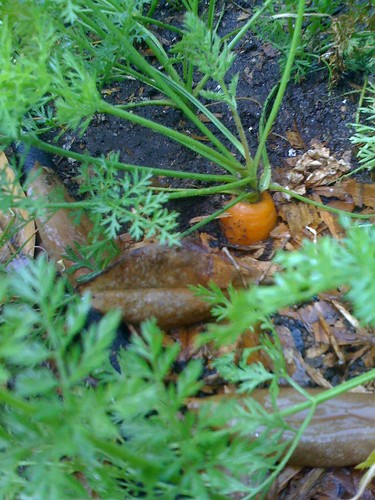
I have always struggled to get carrots, but this sucker is just one of many monsters growing in my plot. I ate this guy right after taking its picture. Very sweet. I am really excited. I will probably make a carrot soup out of this.
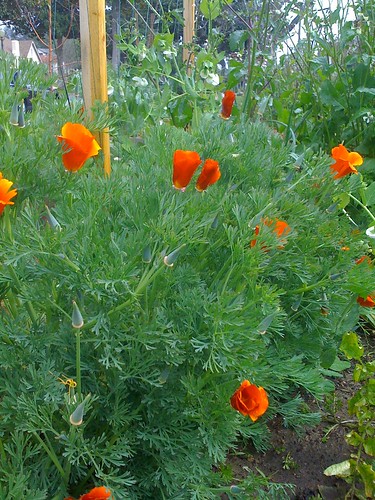
This was a poppy plant that grew from last years planting. It has very reddish-orange flowers. CA poppies are a great harbinger of spring around here. The reddish orange color just glows!

Something (probably pill bugs) is serious going after my potato plants. We'll just see how they do on their own. Good luck guys. I have too much Spring planting right now.

This is "rustic arugula" and is supposed to be similar to "wild arugula". The leaves are way different than standard arugula, much thinner and more "toothed". A tasting will be in short order and I am quite hopeful.

I have always struggled to get carrots, but this sucker is just one of many monsters growing in my plot. I ate this guy right after taking its picture. Very sweet. I am really excited. I will probably make a carrot soup out of this.

This was a poppy plant that grew from last years planting. It has very reddish-orange flowers. CA poppies are a great harbinger of spring around here. The reddish orange color just glows!

Something (probably pill bugs) is serious going after my potato plants. We'll just see how they do on their own. Good luck guys. I have too much Spring planting right now.

This is "rustic arugula" and is supposed to be similar to "wild arugula". The leaves are way different than standard arugula, much thinner and more "toothed". A tasting will be in short order and I am quite hopeful.
Tuesday, March 17, 2009
a really good tomato soup - an antidote to Alice Waters
I want to say, "THE BEST TOMATO SOUP EVAH!!", but it's probably not. It's not my recipe, but another recipe that I found on the tubes. This came via internetfoodassociation.com (great blog) which in turn came from ourkitchensinkrecipes.com. As I have said, I like things that are simple, and really flavorful. This one certainly is that. I think that the kicker is the spiciness in there. From start to finish, it took me thirty five minutes and that was with many interruptions due to kids, etc. Since this is the year of leeks, it is appropriate that this soup depends heavily on leeks for its flavor. I cannot wait to redo this recipe with fresh tomatoes instead of canned. Also, cheap is a major bonus of this recipe. Between the leeks, cream and canned tomatoes, it probably cost $7.50, and served a total of 5 meals.
from my kitchen:
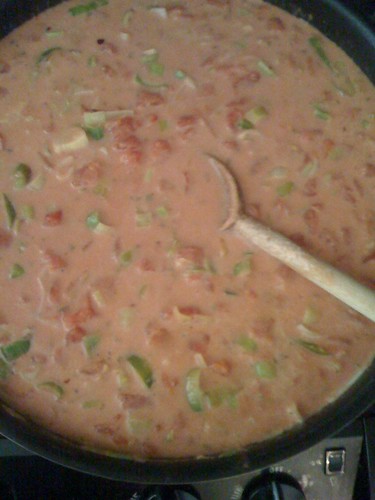
Note: it is not that creamy looking after blending it up. Also, I skipped the caramelized leeks for time and simplicity sake, but that is awfully good when you do it too!
Note again: I actually doubled the recipe, and froze half of it in 16 oz batches so that I made 3 lunches out of it.
So there you have it. This was really healthy, really simple, pretty quick, essentially organic, and quite cheap. I think that other than getting the recipe via a blog it also avoids the pretention factor as well.
from my kitchen:

Note: it is not that creamy looking after blending it up. Also, I skipped the caramelized leeks for time and simplicity sake, but that is awfully good when you do it too!
Note again: I actually doubled the recipe, and froze half of it in 16 oz batches so that I made 3 lunches out of it.
So there you have it. This was really healthy, really simple, pretty quick, essentially organic, and quite cheap. I think that other than getting the recipe via a blog it also avoids the pretention factor as well.
Creamy Tomato-Leek Soup
Adapted from Food & Wine
1 tablespoon unsalted butter
1 tablespoon, plus 2 teaspoons extra-virgin olive oil (divided)
3 leeks, divided (2 thinly sliced in half moons and 1 thinly sliced lengthwise)
3 garlic cloves, smashed
3 14-ounce cans whole tomatoes
1 cup water
1/2 cup heavy cream
1 tablespoon sugar
1/4 teaspoon crushed red pepper
1/4 teaspoon celery seed
1/4 teaspoon dried oregano
salt & pepper, to taste
In a large saucepan, melt the butter in the olive oil. Add the sliced half moons of leeks and smashed garlic and cook over moderate heat, stirring occasionally, until softened, about 5 minutes. Add the tomatoes and their juice, the water, heavy cream, sugar, crushed red pepper, celery seed and oregano and season with salt and pepper. Bring the soup to a boil over high heat, breaking up the tomatoes with the back of a spoon. Reduce the heat to moderate and simmer for 10 minutes.
Working in batches, transfer the tomato soup to a blender and puree until smooth.* Return the soup to a clean pot and rewarm the soup if necessary. Season the soup with salt and pepper.
In a small saucepan, heat the remaining two teaspoons of oil over moderate heat. Add the remaining sliced the leeks (the lengthwise ones) and cook, stirring every so often, until browned and crispy.
Divide the soup among six bowls and garnish with the crispy leeks.
Yield: 6 bowls
* As I said in the post, I used an immersion blender here. I think a food processor would work well too.
Alice Waters is Frustrating!!
Alice Waters, the founder of Chez Panisse, which is by most measures the most influential restaurant in terms of defining the fresh food cooking movement in our country, is so frustrating as a movement leader. Others have made this point here and here, but this video from CBS news interview with her is a PERFECT example. She is so right on that healthy food can be relatively inexpensive and quick to cook.

But she tries to demonstrate the point by going on National Television, cooking a "simple breakfast" for the reporter, and (at about 8:15 minutes into the webcast) cooks an egg in a HAND HAMMERED COPPER COOKING SPOON OVER A FIRE IN A HEARTH BUILT INTO HER KITCHEN. It couldn't look more absurd. IT COULDN'T LOOK MORE ABSURD!!!!!
Perhaps, dialing back her fantasy/obsession with rustic preparation, she could have simply fried that egg up with a little olive oil in a $10 pan over a stove. The meal would have tasted 97% as good, and would have been acessible to 99.9% more people who don't have fireplaces built into their kitchens and hand hammered copper cooking spoons.
changing policy on food will require both a cultural shift as well as policy shifts, that in turn rely on lots of people changing their minds about how we do things. Alice Waters has done an amazing job at pointing the way to better eating. She really needs to step back and not let herself become the face of the new food movement.

But she tries to demonstrate the point by going on National Television, cooking a "simple breakfast" for the reporter, and (at about 8:15 minutes into the webcast) cooks an egg in a HAND HAMMERED COPPER COOKING SPOON OVER A FIRE IN A HEARTH BUILT INTO HER KITCHEN. It couldn't look more absurd. IT COULDN'T LOOK MORE ABSURD!!!!!
Perhaps, dialing back her fantasy/obsession with rustic preparation, she could have simply fried that egg up with a little olive oil in a $10 pan over a stove. The meal would have tasted 97% as good, and would have been acessible to 99.9% more people who don't have fireplaces built into their kitchens and hand hammered copper cooking spoons.
changing policy on food will require both a cultural shift as well as policy shifts, that in turn rely on lots of people changing their minds about how we do things. Alice Waters has done an amazing job at pointing the way to better eating. She really needs to step back and not let herself become the face of the new food movement.
Saturday, March 14, 2009
on my bedside table...
and bathroom floor, and living room tables, and kitchen table. I think you get the point. At least of how my wife feels about the books that I take a shine to. The follow me around the house in no discernible order or timing, leaving the "impression" of messiness...
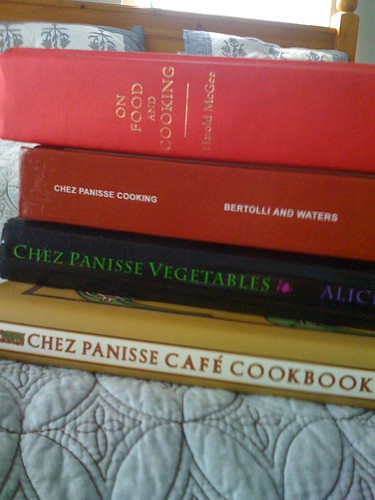
Anyway, I wanted to review four books that I received as Christmas presents. Thanks Mom! They are all good, but two of these stand out as somewhat essential for the home gardener/cook, those of us that fashion ourselves as cooking from a potager and like food with fresh taste.
On Food and Cooking
Chez Panisse Cooking - This was/is my favorite of the bunch. Kitchen gardeners will immediately be taken with this one, I think. It is a romantic yet (mostly) practical guide to cooking with ingredients that are as fresh as the ones we have to work with out of our garden. This book could have been written today and been well-regarded. That it was written 20 years ago is simply incredible and is a testament to how forward-looking Chez Panisse is. Paul Bertolli has a very accessible appreciation for simple, rustic flavors and a sophisticated understanding of the origins of ingredients. While many recipes would require too much work for most of us, there are many that are simple, but with the right ingredients are fantastic. I will be spending a lot of time this summer working my way through this one.
I want to write much more about this one, but suffice it to say, I will have more to say as I try out a number of recipes. I may be able to start soon with spinach soup as I have some spinach in the garden that tastes great, but does not look so presentable. Or possibly a double soup, spinach soup and carrot soup, paired in a bowl.

double soup
Chez Panisse Vegetables
Chez Panisse Cafe Cookbook
UPDATE: ARRRRGGH!!! just lost a lot of edits here. will update tomorrow. this is way undone!!! OOHHHH, I am MADDDDDDD!!!! I was Brilliant!!

Anyway, I wanted to review four books that I received as Christmas presents. Thanks Mom! They are all good, but two of these stand out as somewhat essential for the home gardener/cook, those of us that fashion ourselves as cooking from a potager and like food with fresh taste.
On Food and Cooking
Chez Panisse Cooking - This was/is my favorite of the bunch. Kitchen gardeners will immediately be taken with this one, I think. It is a romantic yet (mostly) practical guide to cooking with ingredients that are as fresh as the ones we have to work with out of our garden. This book could have been written today and been well-regarded. That it was written 20 years ago is simply incredible and is a testament to how forward-looking Chez Panisse is. Paul Bertolli has a very accessible appreciation for simple, rustic flavors and a sophisticated understanding of the origins of ingredients. While many recipes would require too much work for most of us, there are many that are simple, but with the right ingredients are fantastic. I will be spending a lot of time this summer working my way through this one.
I want to write much more about this one, but suffice it to say, I will have more to say as I try out a number of recipes. I may be able to start soon with spinach soup as I have some spinach in the garden that tastes great, but does not look so presentable. Or possibly a double soup, spinach soup and carrot soup, paired in a bowl.

double soup
Chez Panisse Vegetables
Chez Panisse Cafe Cookbook
UPDATE: ARRRRGGH!!! just lost a lot of edits here. will update tomorrow. this is way undone!!! OOHHHH, I am MADDDDDDD!!!! I was Brilliant!!
Thursday, March 12, 2009
Year of Leeks
This year, I am determined to get something going with leeks. I was inspired last year when I was helping my mother-in-law in Oregon plant her garden, and at her local nursery had these amazing flats of leeks with probably 100 little leeks in there for like $4. I have never seen anything like that in So. Cal. So I decided to start a flat myself.
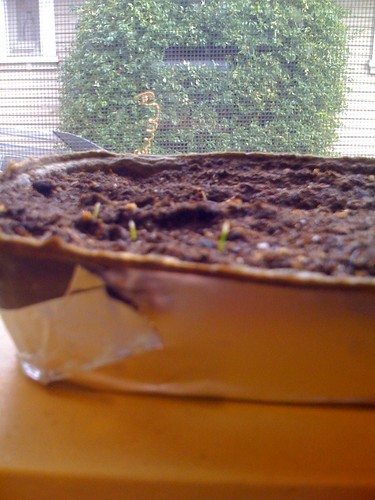
You can just barely see the leeks emerging in this pick and they are getting bigger now. We'll see how things go. But leeks are really good and really underutilized in American cooking, so I am setting about to change that. One Front Yard Garden at a time.
Fortunately, I just came across this post by David Lebovitz about the glories of leeks. with better pictures than mine. He does a great job describing why leeks are so good in cooking. i.e. more mellow onion flavor.

So, have at it. I am going for it with leeks this year, let me know if you have any good sources that I don't know about.

You can just barely see the leeks emerging in this pick and they are getting bigger now. We'll see how things go. But leeks are really good and really underutilized in American cooking, so I am setting about to change that. One Front Yard Garden at a time.
Fortunately, I just came across this post by David Lebovitz about the glories of leeks. with better pictures than mine. He does a great job describing why leeks are so good in cooking. i.e. more mellow onion flavor.

So, have at it. I am going for it with leeks this year, let me know if you have any good sources that I don't know about.
Wednesday, March 11, 2009
front yard right now
I want to wait until I get the perfect picture, but when does that happen? In the interest of not letting the perfect be the enemy of the good here is fyg, march 2009:
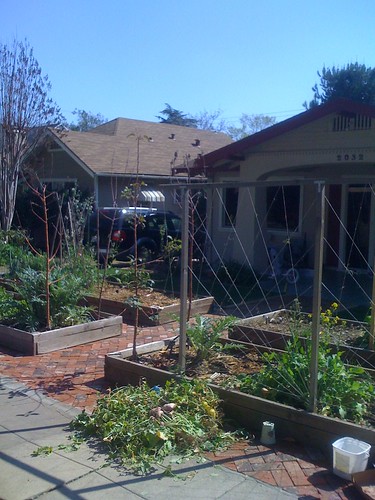
note the pile of old snap peas and bucket of bone meal in preparation for the tomato plants that just went in.

note the pile of old snap peas and bucket of bone meal in preparation for the tomato plants that just went in.
Tuesday, March 10, 2009
you think people are interested in this stuff, maybe?
interesting post by michael pollan at the NY Times "Well Blog", asking for "eating rules" that people have grown up with or come up with on their own. It's for his next project. But what is interesting is how many responses/comments he got on the post. 1,593!!! On one blog post. So I ask again, "you think people are a little bit interested in this stuff?"
greatest herb mix ever
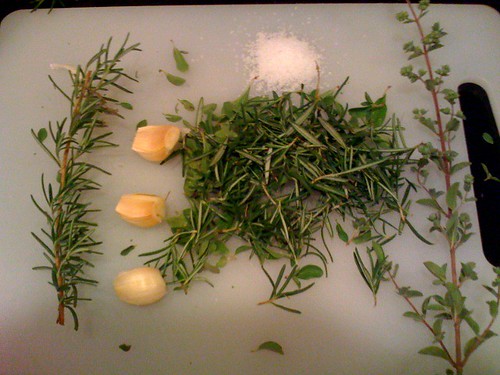
Thanks to David Liebowitz, I discovered the great use of meat rubs, that can be prepared, saved and used any time to provide a robust flavor to a variety of meats. I rarely get to save it because I usually make it right before preparing some large turkey which uses most of it up. I will discuss the preparation and use.
First, the preparation. As you can see in the picture above, you use a healthy amount of the following: rosemary, garlic, marjoram (or originally sage), and salt. I am being pretty vague, because frankly, as long as you are using lots of fresh herbs, the precise proportions are not too important. I will include David's instructions below. Chop all of these together and it looks like this:

at this point if you don't use it, spread it on a cookie sheet to let it dry. it will be dry in 24-48 hours. The smell is amazing!
As for use, it is pretty straightforward. Rub it on the meat. Cook the meat.
Ok, but if you really want to know why I love this rub so much, I will tell you how I use it on turkey, for which I have received some pretty rave reviews...
Blueberries Blossoms
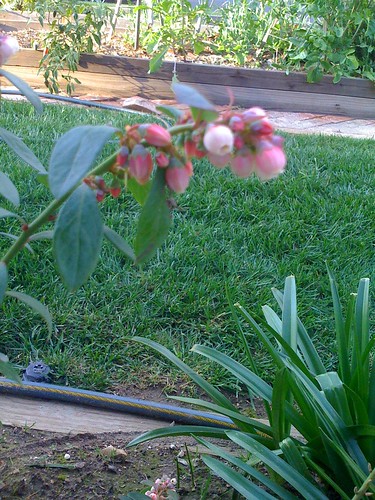
This year will be the first year that we have three blueberry bushes in full effect. They are currently loaded with blossoms that are turning into baby blueberries. I was amazed last year at how many blueberries a bush produces. I didn't measure it, but I expected a couple handfuls because my bushes were small. But each bush kept on producing handful after handful, which made me very, very happy. And they were good!
If you want to get inspired, this article is a good place to start. It is what inspired me. I am seeing blueberry bushes everywhere these days, so give them a try. If you live in Pasadena, there is a guy that sells great bushes at excellent prices at the Saturday Farmers Market.
Thursday, March 5, 2009
Interesting Food for Thought

I, like many, have wrestled with thoughts about how to take a really big agricultural system that produces tremendous amounts of cheap food and relies on lots of artificial inputs, and turn that into a sustainable, organic system that can produce the same goods at roughly the same cost, but without all the nasty inputs.
This article in Mother Jones is provocative and written by a strong critic of our industrialized system. The short version is that what if instead of having such a black and white divide between conventional/organic agriculture, we could have a system that gave incentives to farmers to reduce nasty inputs by 80%. Wouldn't that also be a more sustainable path. Also, perhaps 100% organic is not sustainable.
I think that he sells some organic solutions short, but it is an important topic.
Subscribe to:
Posts (Atom)